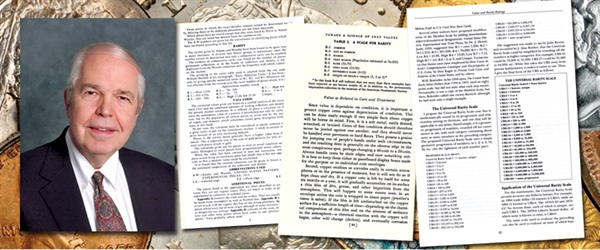
In the early 1990s, I devised the Universal Rarity Scale. As of that time, there were several different rarity scales in use, some mainstream such as the one proposed by Dr. William H. Sheldon in 1949, and others obscure—such as that created by Edgar H. Adams and William H. Woodin to describe patterns. The Fuld books on Civil War tokens had yet another system.
All of these applied to coins, tokens, medals, and currency that ranged from unique to 1,000 or so estimated to exist. For coins of which tens of thousands or millions exist—say Proof coins from 1950 to date, Morgan silver dollars of all dates and mintmarks except 1895 Philadelphia, modern commemoratives, and more, there was no applicable rarity scale.
The Universal Rarity Scale is mathematically sound in its progression and relationship among its divisions and is applicable to any series. Stated simply, it is a geometric progression of numbers, rounded off for convenience in use, with each category containing about twice as many members as the preceding category. The proposed Universal Rarity Scale uses a simple geometric progression of numbers, as 1, 2, 4, 8, 16, 32, etc. (see the rightmost of each number pair):
THE UNIVERSAL RARITY SCALE
Universal Rarity Scale-0 = None known
URS-1 = 1 known, unique
URS-2 = 2 known
URS-3 = 3 or 4
URS-4 = 5 to 8
URS-5 = 9 to 16
URS-6 = 17 to 32
URS-7 = 33 to 64
URS-8 = 65 to 124
URS-9 = 125 to 249
URS-10 = 250 to 499
URS-11 = 500 to 999
URS-12 = 1,000 to 1,999
URS-13 = 2,000 to 3,999
URS-14 = 4,000 to 7,999
URS-15 = 8,000 to 15,999
URS-16 = 16,000 to 31,999
URS-17 = 32,000 to 64,999
URS-18 = 65,000 to 124,999
URS-19 = 125,000 to 249,999
URS-20 = 250,000 to 499,999
URS-21 = 500,000 to 999,999
URS-22 = 1,000,000 to 1,999,999
URS-23 = 2,000,000 to 3,999,999
URS-24 = 4,000,000 to 7,999,999
URS-25 = 8,000,000 to 15,999,999
URS-26> = same progression
Application of the Universal Rarity Scale
For the numismatist, the Universal Rarity Scale permits accuracy not hitherto known. For example, an 1884 trade dollar (10 known) is URS-5, while an 1885 (5 known) is URS-4. The 1870-S $3 and 1873-CC no-arrows dime, each of which is unique, are each URS-1. The 1873-S Liberty Seated dollar, of which none is known to exist, is URS-0.
The same scale used to evaluate the preceding can also be used to evaluate an issue of which hundreds of thousands of coins are known. Thus, we know that the General Services Administration disposed of 675,000 Mint State 1884-CC dollars in the 1970s, and, in addition, probably a hundred thousand or more Mint State 1884-CC dollars were released before then. Under the Universal Rarity Scale, the Mint State 1884-CC can be described as URS-21 (500,001 to 1,000,000 known). A 1989-S Proof set (of which 3,005,776 were sold) is URS-23.
With the Universal Rarity Scale, collectors of modern Proof sets, silver dollars, Hard Times tokens, large cents, and other series can all talk the same language.
In contrast, using the Sheldon Scale, a Mint State 1879-CC dollar, a “scarce” or “rare” coin to any specialist in the Morgan dollar field, would be listed as R-1, or “common,” as, perhaps, 10,000 Mint State coins are known. Similarly, a Very Fine 1893-S Morgan dollar would be R-1 per Sheldon. In fact, not a single circulation strike Morgan dollar issue would be even R-4 on the Sheldon Scale! Listed as R-1 on the Sheldon scale would be the elusive 1879-CC as well as the very common 1881-S. Under the Universal Rarity Scale, the Mint State 1879-CC would be URS-15, while the common 1881-S would be URS-22. The seldom-seen Proof 1895 would be URS-11. In Mint State, the very rare 1893-S would be URS-6.
By means of the URS notation, anyone wanting to quickly compare rarities of various coins across different series can do so easily.
Should anyone else wish to use it, the Universal Rarity Scale is available without license or credit line. A satisfactory way to use it is as follows: “1885 trade dollar. URS-4.”
In cooperation with the Professional Coin Grading Service I donated this to the “public domain.” Since then it has been used in a number of reference books with great success.





